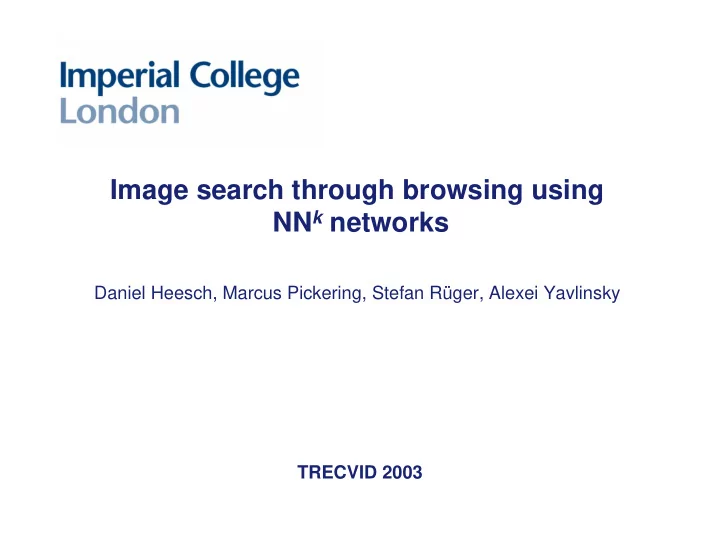

Image search through browsing using NN k networks Daniel Heesch, Marcus Pickering, Stefan Rüger, Alexei Yavlinsky TRECVID 2003
Overview • Image and Collection Preprocessing • Search and Relevance Feedback • Temporal Browsing and NN k Browsing • TVID Results
Preprocessing • Use only common keyframes + LIMSI transcript • Removal of bottom 51 lines
11 Primitive Features • 4 Colour – global HSV, centre HSV, marginal RGB colour moments, colour structure descriptor • 2 Structure – convolution map features on grey image • 3 Texture – simple features on image tiles • 1 Annotation – Bag of stemmed-words (tf-idf) • 1 Localisation – Thumbnail of grey image
44x27 Thumbnail: Ad detection • average pixel difference between two thumbnails ��������� �����������������������������
Distance of topic Q to image i given feature f • dist f : Manhatten • KNN distance – positive examples (set Q) – negative examples (set N, random)
Fusion of features • Convex combination • w is the “plasticity” of our retrieval system
Relevance Feedback � ���� � �
Relevance Feedback • Minimize with respect to w and convexity constraint.
Browsing • Hierarchical (not yet) • In ranked list (not shown) • Temporal • Lateral
Temporal Browsing • Movement along a sequence of shots
Temporal Browsing • Movement along a sequence of shots
Temporal Browsing • Movement along a sequence of shots
Temporal Browsing • Movement along a sequence of shots • Q: Add to query panel • A: Add to assembly panel
Assembly panel
Pruning Panel
Lateral Browsing • Images as vertices in a directed graph • Instantiate arc (i,j) iff there is a feature combination w such that j is closest to i • NN k network
NN k Network construction • For each image • for each w determine nearest neighbour and compute corresponding proportion of weight space (= edge weight) • store adjacent images and edge weights
Sampling the weight space ����� ���� ��� ���������
Rationale • exposure of semantic richness • user decides which image meaning is the correct one • network precomputed �� interactive • supports search without query formulation
Properties • small average distance between any two vertices (three nodes for 32,000 images) • high clustering coefficient: an image´s neighbours are likely to be neighbours themselves • vertex degrees follow power-law distribution �� scale-free small-world graph
Browsing interface • Initial display: query-by-example retrieval result OR high connectivity nodes (hubs) • Clicking on an image moves it into the center and displays all adjacent nodes in the network
Observations • Browsing can help to explore visual similarity • Some task are impossible with browsing alone: find video shots with Senator Mark Sounder • Browsing can be a fun activity
Interactive runs Runs Search Relevance Browsing Feedback I II III IV
Experimental design • 4 subjects, 4 runs �� square lattice design T1-6 T7-12 T13-18 T19-25 S1 I II III IV S2 IV I II III S3 III IV I II S4 II III IV I
Results MAP RANK (out of 36) Best 0.46 Median 0.19 Mean 0.18 S + RF + B 0.26 5 S + RF 0.26 4 S + B 0.23 8 B 0.13 27
Conclusions • Competitive system: Three out of four runs among the top 8 (of 36) • “Search by browsing‘‘ a viable alternative to traditional search by example for visual topics
Recommend
More recommend